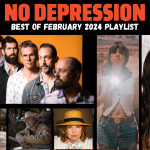From Newgrass to… Grass Nouveau?
The history of any art form can eventually be traced back to its folk roots. The rich and subtle paintings of DaVinci or Vermeer have their antecedents in the simplified cave paintings of Lascaux. The delicate sculpture of Michelangelo, Bernini, or Rodin find their roots in the bluntly voluptuous Venus figures from tens of thousands of years ago. Of course, these folk forms endure through history, patiently awaiting their next cycle of rediscovery by future generations who re-appropriate and re-render them in their own contemporary image. This tension between the “primitive” forms of old and the “sophisticated” forms of educated artists informs much of the most celebrated modern art – see Picasso, Gauguin, Brancusi, and Dubuffet as famous examples. I can’t help but feel that roots-oriented music is entering a similar cycle where highly technical players are applying erudite musical knowledge with some of the oldest folk forms of American music (which were, in turn, derived from even older European and African forms.) I’m not sure what the hell to call it, though…
I began thinking about this after seeing the Punch Brothers play an hour long set at Grimey’s Record Shop in Nashville this weekend. For those unfamiliar, the band is composed of what would normally be traditional bluegrass instrumentation – mandolin (Chris Thile of Nickel Creek fame), fiddle (Gabe Witcher), banjo (Noam Pikelny), guitar (Chris Eldridge), and double bass (Paul Kowert). However, the Punch Brothers’ intricate melodies, harmonic density, lively counterpoint, and wild shifts both dynamically and rhythmically owe almost as much to classical music conventions as they do bluegrass. They take this form, the standard bluegrass band setup, several steps beyond the Newgrass music pioneered by John Hartford, Sam Bush, J.D. Crowe, and others in the 70’s and 80’s. It’s very difficult to classify.
While the taxonomy and categorizing of music can be a painfully frivolous endeavor, it can also be convenient. I’ve described the Punch Brothers and other groups with similar characteristics as chamber music with a strong bluegrass/old-time influence. (To emphasize that point, the Punch Brothers were heading to Vanderbilt University’s Ingram Hall, a fine-arts theater with a “chamber music” vibe and hefty price tag, right after their free afternoon in-store appearance.) So, perhaps Chambergrass might be appropriate? Or, instead of Newgrass, how about Grass Nouveau (because let’s face it, everything sounds more sophisticated in French)? None of this “highfalutin” wording is meant to imply that Grass Nouveau can’t be a foot-stopping, ass-shaking good time. It definitely can (and was on Saturday.) However, its complex forms can also make for pure head music, perfectly suited to strap on some ear cans, slurp down bong hits, and waste an afternoon drooling in a beanbag for those so inclined. Also, it can provide dense educational fodder for serious music nerds looking to study some pretty heavy compositions. In fact, the supercharged versatility of Grass Nouvea is its greatest strength, though its practitioners are few and far between (to this writer’s knowledge, anyway.)
__________________________
Dustin Ogdin is a freelance writer and journalist based in Nashville, TN. His work has been featured by MTV News, the Associated Press, and various other stops in the vast environs of the world wide web. His personal blog and home base is Ear•Tyme Music. Click below to read more and network with Dustin.
Ear•Tyme blog… 






